Identifying trees in Winter is hard. It isn’t too bad in Spring, Summer and Autumn; But during the winter, when there are no leaves, flowers or fruits on show, it’s pretty tricky. Its a useful skill however, that can really take your foraging to the next level…
Why trees? What has that got to do with foraging?
The obvious reason is that some have edible parts. The fruit of Sweet Chestnut, Acorns (after processing), and Apples for example. But there’s a secondary reason too. Trees can point toward other edible resources. For example, Cattails (or Greater Reed Mace) grow in water and are available all year round as a food source. Willow and Alder trees also like to grow near water. So, if you can spot Willow and/or Alder trees in winter, there may be Cattails nearby too.
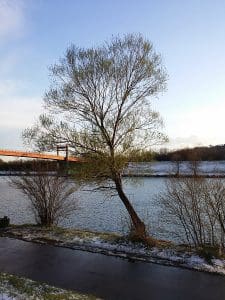
So what about when there are no leaves, flowers or fruit to help me?
Honestly, part of me doesn’t really care that much (I know, you’re horrified, right?) But seriously, unless I’m in a survival situation, they’re no use to me in the Winter, and I can always come back later and identify them when it’s easier. That said, maybe you’re out and about and you want to know whether it’s worth coming back in the productive seasons. So, here’s a quick run down on a few things that can help. If after reading this you are ready to dive in to some intense detail on various species, check out Forager Janes article here.
Apps and Books to use
I have the “British Trees” app from the Woodland Trust, and that’s quite good. I also use the Collins Gem “Trees” book; Mostly because it’s small and easy to carry around. There are many other tree reference books that you could refer to at home when returning with lots of pictures – You could use your local library to try a few out for free before buying the ones that work best with your learning style.
Parts of a tree that can help in identification
That’ll be all the parts you can see, and sometimes, where the tree is. Including: bark, general shape/outline, twigs, leaf buds (which are present throughout Autumn and Winter, not just in Spring), any remaining fruit and/or seeds/cones, any remaining leaves/needles, and any remaining flowers (some catkins remain through the winter). Also, don’t forget to look down; There could be leaf litter and other evidence on the floor around the tree.
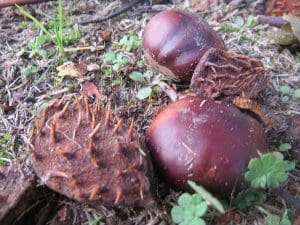
Leaves or not?
Probably the most obvious place to start would be whether it has leaves through the winter or not. If it does, then you have leaf shapes to look at too, such as the needle-like leaves of conifers, or the spiky, shiny leaves of Holly for example.
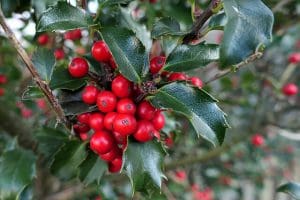
Location
The location of a tree can be helpful in identification. As I mentioned before, certain trees like to be in wet, marshy ground; Or Scots pine, for example tends to be found in poor soil, rocky areas, and generally where other trees don’t like to grow.
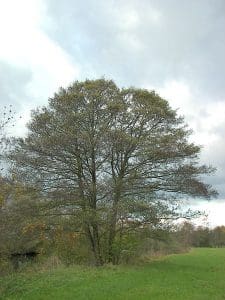
Shape
The shape of a tree from a distance can also give you a starting point. If your tree is in the middle of a forest, this isn’t so easy, but if you can see the whole thing you may be able to begin with trees that grow tall and thin, or short and wide, warped and twisted, etc.
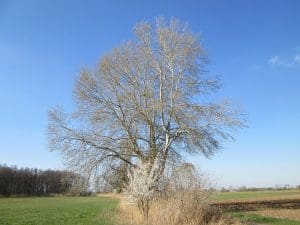
Bark
The bark of a tree is there year-round and can be a key identifier. Birches with their white, peel-able bark, Cherries and Plums with their shiny, red-ish bark with horizontal lenticels, Poplar with their creepy, eye-like markings, and so on.
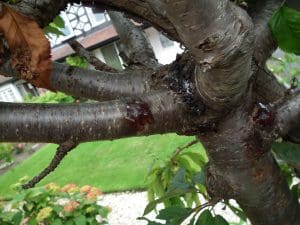
Twigs
Twigs can be hairy or hairless, slightly different colours, with or without glands, fine and delicate or more substantial, and the arrangement of buds on the twigs can be useful too.
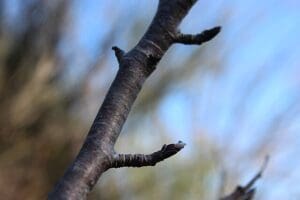
Leaf buds
Contrary to popular belief, the leaf buds on trees are generally there throughout winter and are quite different between tree species. For example, Beech buds are long (up to 2 cm), slender, very pointed, red-ish brown, with obvious scales; Oak are shorter, egg-shaped, orange brown, and form in clusters at the shoot tips.
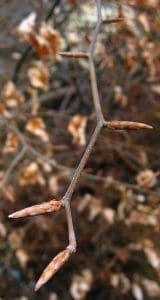
Other features
Some trees have other features which you can look out for too. For example, Common Alder cones tend to remain on the tree into the next season; Common Hawthorn has short, sharp thorns throughout; Blackthorn has long, vicious-looking thorns throughout and so on.
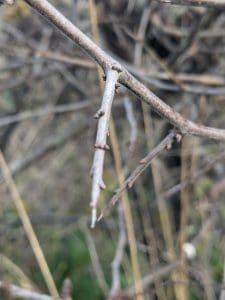
Finally
I hope you’ve found this helpful. It’s not meant to be a guide to identification, just a few pointers to help you get started. Of course theres no substitute for hands on practice, so why not join one of our expert foragers on a Winter foraging walk?
Happy tree hunting!





